Physical Address
304 North Cardinal St.
Dorchester Center, MA 02124
Tumors of the pituitary gland and sellar region represent approximately 15% of all brain tumors, and the most common primary brain tumor by histologic type in person age 15 to 39 years. Numerous types of tumors may involve the sellar region, reflecting its complex anatomy. Table 17.1 lists the most frequent tumors arising in the sellar and parasellar regions. The most common tumors are, by far, the pituitary adenomas, benign neuroendocrine tumors derived from cells of the adenohypophysis. In fact, pituitary adenomas represent the third most common primary intracranial tumor in neurosurgical practice, outnumbered only by gliomas and meningiomas. In the author's institution, pituitary adenomas represent about 75% of sellar lesions ( Table 17.2 ). Pituitary adenomas predominantly affect females between the third and sixth decades; however, no age group is spared. Adenomas are uncommon in the pediatric population and most tumors of childhood are clinically functioning adenomas. Rates for pituitary tumors in the United States are slightly higher among blacks than whites. Incidental adenomas can be found in nearly 10% of autopsied patients.
| Location | Lesions |
|---|---|
| Anterior pituitary |
|
| Posterior pituitary |
|
| Tumors of nonpituitary origin |
|
| Cystic lesions |
|
| Inflammatory lesions |
|
| Lesion | Frequency (%) |
|---|---|
| Pituitary adenoma | 74 |
| Rathke cleft cyst (RCC) | 5 |
| Craniopharyngioma | 4 |
| Pituitary apoplexy | 2 |
| Cysts (other than RCC) | 2 |
| Inflammatory lesions | 1 |
| Metastases | 1 |
| Meningiomas | 1 |
| Miscellaneous | 1 |
| Normal pituitary a | 9 |
a Most of the cases were clinically suspicious for adenomas.
Comparatively, primary tumors of the neurohypophysis are rare and important in the differential diagnosis of nonfunctioning adenomas (see Table 17.1 ). The neurohypophysis, however, is a common site for metastases.
In addition to tumors, a variety of nonneoplastic lesions may affect the pituitary gland, bringing a number of processes into the differential diagnosis of tumors involving this region. In this chapter, only the most common and more unique entities involving the sellar region will be discussed.
The adult human pituitary is a bean-shaped gland located within a small bony box, the sella turcica, under the base of the brain. The gland measures approximately 13 × 9 × 6 mm and weighs about 0.6 g, with some variation (0.4–0.9 g) depending on gender. The gland tends to be heavier in women than in men, particularly during pregnancy and lactation.
The pituitary gland is divided into two basic parts: the anterior pituitary (or adenohypophysis) and the posterior pituitary (or neurohypophysis). The anterior pituitary constitutes the largest portion of the gland, approximately 75% to 80%, and has three components: (1) the pars distalis, (2) the pars intermedia, and (3) the pars tuberalis. The adenohypophysis is epithelial in origin and arises from the Rathke pouch, an invagination in the oral ectoderm. The posterior pituitary is derived from neuroectoderm, arising as an outpouching from the floor of the third ventricle. The neurohypophysis is composed of the pars nervosa and the pituitary stalk (or infundibulum), which connects the gland directly to the brain. The gland is covered by dura mater, a continuation of the dura mater from the base of the skull. The dura separates into two layers: one layer lines the floor of the sella turcica and the other layer forms, at the level of the pituitary stalk, the diaphragma sellae. The pituitary gland is surrounded by many important anatomic structures. Laterally to the pituitary are the cavernous sinuses containing the internal carotid arteries, venous plexuses, and cranial nerves III through VI. Superiorly located are the optic chiasma and optic tracts, and inferiorly are the sphenoid bone and sphenoidal sinuses.
The anterior pituitary has a great variety of cell types and functions ( Figs. 17.1, 17.2, and 17.3 ). The Rathke pouch gives rise to at least six pituitary-specific cell lineages. Five of these cell types are functionally defined by the hormone that they produce (see Fig. 17.3 ):
Somatotrophs: growth hormone (GH)
Lactotrophs: prolactin (PRL)
Corticotrophs: adrenocorticotropic hormone (ACTH)
Thyrotrophs: thyroid-stimulating hormone (TSH)
Gonadotrophs: both follicle-stimulating hormone (FSH) and luteinizing hormone (LH)
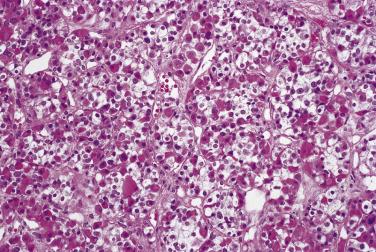
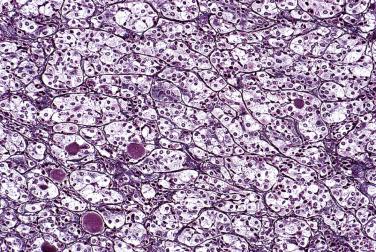
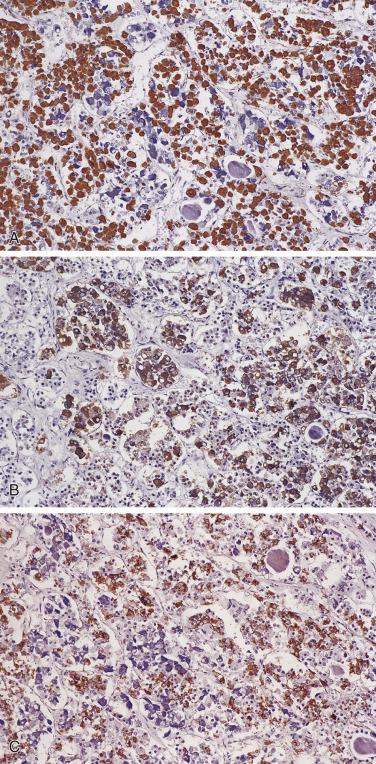
During pituitary organogenesis, the cytodifferentiation of these five cell types appears to be a reflection of the temporal gene expression of their different hormones and under control of specific cell-restricted transcription factors. The acidophilic cell lineage, including somatotrophs, lactotrophs, and thyrotrophs, requires pituitary transcription factor-1 (Pit-1) and PROP paired-like homeobox 1 (PROP-1) for their differentiation. In gonadotrophs, steroidogenic factor 1 (SF1) and GATA-binding protein 2 (GATA-2) play positive roles in activation of gonadotroph-specific genes for determination and differentiation. The transcription factors NeuroD1 and Tpit (T-box transcription factor) have been identified as restricted to proopiomelanocortin (POMC)–expressing lineages, corticotrophs, and melanotrophs.
The sixth cellular component present in the anterior pituitary is the folliculostellate cell, a specialized sustentacular-like cell that appears to have multiple functions related to phagocytosis, secretion of growth factors, and intercellular communication.
Microscopically, the anterior pituitary exhibits a distinct acinar architecture easily appreciated by reticulin stain (see Fig. 17.2 ). Each acinus is composed of an admixture of various secretory cell types (see Fig. 17.1 ). However, a preferential intraglandular distribution of the different cell types is seen. Somatotrophs, the most abundant cells, are located predominantly in the lateral wings of the gland. Corticotrophs, representing 10% to 15% of all adenohypophyseal cells, are mainly located within the central wedge, anteriorly to the posterior lobe. Lactotrophs can be found everywhere within the anterior lobe, and gonadotrophs are widely distributed throughout the gland, having no favored site of accumulation. Thyrotrophs, accounting for fewer than 5% of all adenohypophyseal cells, are mostly located in a small area in the anteromedial aspect of the central wedge.
The posterior pituitary (neurohypophysis) consists of an interlacing network of axons and nerve fibers and specialized glial cells known as pituicytes. Morphologically pituicytes are elongated unipolar or bipolar cells that display prolongation of the cytoplasm into one or more axonal processes. Pituicytes are strongly positive for glial fibrillary acidic protein (GFAP) and demonstrate nuclear expression of the thyroid transcription factor 1 (TTF1). Similar to glial cells of other areas of the central nervous system, pituicytes extend cell processes to adjacent connective tissue or to a blood vessel wall.
Important to mention is the occurrence of basophilic invasion of the posterior lobe. Invasion of basophilic, ACTH-immunoreactive cells into the substance of the posterior pituitary appears to be an age-dependent process occurring at the interface of the anterior and posterior lobes. Although this is a normal process without clinical significance, its recognition is important for preventing misinterpretation as a basophilic adenoma invading the posterior gland.
Pituitary neuroendocrine tumors are classified into pituitary adenomas and pituitary carcinomas. The majority of tumors are typical adenomas with bland histologic features, infrequent mitotic figures, and a low Ki-67 proliferative index (<3%). Pituitary carcinomas are rare, comprising less than 1% of all pituitary neoplasms. By definition, pituitary carcinomas are characterized by the demonstration of either craniospinal dissemination or systemic metastases. The designation of atypical adenoma, previously recommended by the 2014 World Health Organization (WHO) classification and referred to adenomas with elevated mitoses, and high expression of Ki-67 or p53, has been abandoned recently in the 2017 WHO classification due to its poor reproducibility and predictive value.
Pituitary adenomas are histopathologically classified by the WHO according to the hormone content of the tumor cells as assessed by immunohistochemical stains ( Table 17.3 ). This immunohistochemical classification provides significant information for clinical practice. Moreover, the WHO classification recognizes the role of transcription factors, in particular Pit-1, SF1, and Tpit, in tumor's differentiation according to cellular lineage, in the regulation of specific pituitary hormones and possible pathogenesis of these tumors. These transcription factors have been localized in human pituitary neuroendocrine tumors in a pattern similar to normal pituitary cell differentiation and therefore serve as diagnostic tools. Accordingly, acidophilic lineage adenomas, including somatotroph, lactotroph, mixed somatotroph-lactotroph, and thyrotroph adenomas, have been demonstrated to express strong nuclear staining for Pit-1 while corticotroph and gonadotroph adenomas are negative for Pit-1 expression. Tpit is specific to POMC-producing adenomas including clinically active and silent corticotroph adenomas. SF1 expression is characteristic of gonadotroph adenomas, and it is a differentiating marker between gonadotroph and null cell adenomas. Reliable monoclonal antibodies recognizing all three transcription factors—Pit-1, SF1, and Tpit—have been clinically validated for their utilization in clinical laboratories.
| Adenoma Types | Morphologic Variants | Immunohistochemistry | Transcription Factors |
|---|---|---|---|
| SOMATROTROPH ADENOMA | |||
| Densely granulated adenoma * | GH ± PRL, α-SU CK (diffuse pattern) |
Pit-1 | |
| Sparsely granulated adenoma | GH ± PRL CK (dotlike pattern [i.e., fibrous bodies]) |
Pit-1 | |
| Mammosomatotroph adenoma | GH + PRL (in same cell) ± α-SU | Pit-1 | |
| Mixed somatotroph-lactotroph adenoma | GH + PRL (in different cells) ± α-SU | Pit-1 | |
| LACTOTROPH ADENOMA | |||
| Sparsely granulated adenoma * | PRL | Pit-1 | |
| Densely granulated adenoma | PRL | Pit-1 | |
| Acidophilic stem cell adenoma | PRL, GH (focal and variable) | ||
| THYROTROPH ADENOMA | |||
| β-TSH, α-SU | Pit-1 | ||
| CORTICOTROPH ADENOMA | |||
| Densely granulated adenoma * | ACTH | Tpit | |
| Sparsely granulated adenoma | ACTH | Tpit | |
| Crooke cell adenoma | ACTH CK (ringlike pattern) |
Tpit | |
| GONADOTROPH ADENOMA | β-FSH, β-LH, α-SU (various combinations) | SF1, GATA2 | |
| NULL CELL ADENOMA | |||
| None | None | ||
| PLURIHORMONAL ADENOMAS | |||
| Plurihormonal Pit-1 positive adenoma (previously termed silent subtype 3 adenoma ) | GH, PRL, β-TSH ± α-subunit | Pit-1 | |
| Adenomas with unusual immunohistochemical combinations | Various combinations | N/A | |
Pituitary adenomas are clinically classified in two main groups: the clinically functioning adenomas and the clinically nonfunctioning adenomas, according to whether an endocrine syndrome is present. Most adenomas are functioning tumors and include PRL-producing, GH-producing, ACTH-producing, and TSH-producing adenomas. However, about a third of all pituitary adenomas are unassociated with either clinical or biochemical evidence of hormone excess. In this group are included gonadotroph adenomas that secrete both FSH and LH, the null cell adenomas, and the silent adenomas. These clinically nonfunctioning adenomas commonly present with symptoms related to local mass effect such as headaches; neurologic deficits in the cranial nerves, including visual field disturbances; and mild hyperprolactinemia resulting from pituitary stalk compression (the so-called stalk effect).
According to tumor size and gross anatomic features, adenomas are divided into microadenomas (tumors <1 cm in diameter) and macroadenomas (tumors >1 cm in diameter) ( Fig. 17.4 ). Giant adenomas (tumors >4 cm) rarely occur. Macroadenomas show an increased tendency toward suprasellar extension, gross invasion, and recurrence. A radiologic classification, proposed by Hardy, is the most widely used in clinical practice.
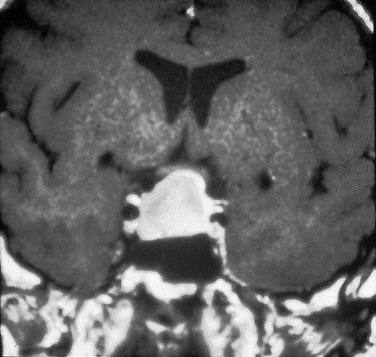
Pituitary adenomas are grossly soft lesions with tan-brown discoloration ( Fig. 17.5 ). Morphologically adenomas may show a variety of histologic growth patterns, including diffuse, papillary, and trabecular arrangements similar to other neuroendocrine tumors ( Fig. 17.6 ), which can be present in any adenoma type. Although these histologic features are of no prognostic significance, their recognition is important in the study of the various lesions that may be considered in the differential diagnosis of pituitary adenomas. Cytologically tumor cells may be acidophilic, basophilic, or chromophobe; however, these tintorial characteristics do not identify specific adenoma types. Most pituitary adenomas are immunopositive for neuroendocrine markers including synaptophysin and chromogranin A; the exception being lactotroph adenomas that show only focal staining with these markers. Tumors are focally immunoreactive for cytokeratin (CK), in particular low molecular weight CK (CK 7/8 [CAM5.2] or CK18).
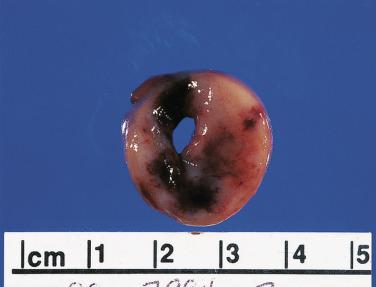
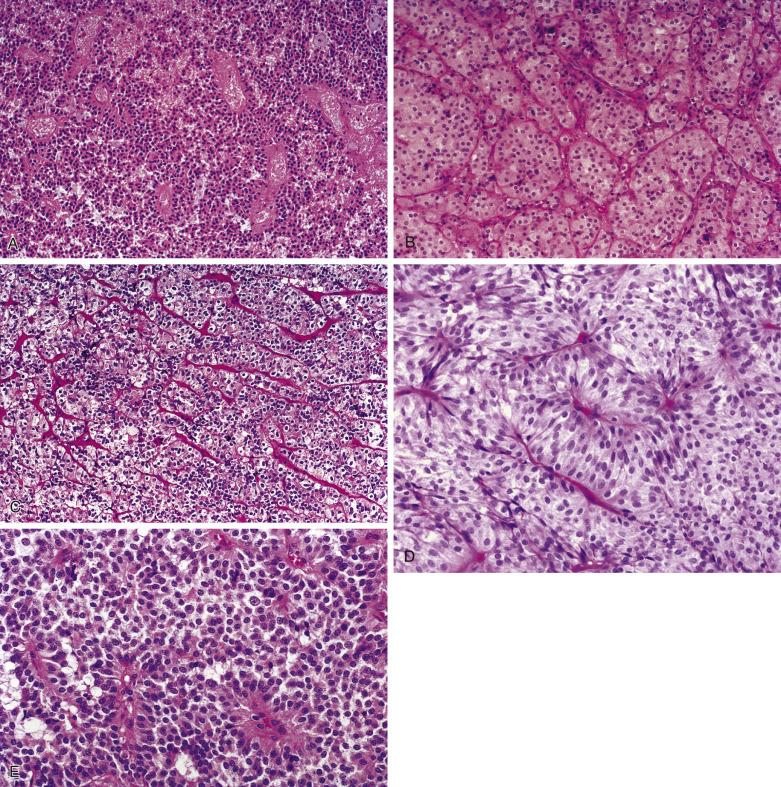
As mentioned, pituitary adenomas are classified according to the hormone content of the tumor cells as assessed by immunohistochemical stains. Rarely, immunohistochemistry alone does not discriminate specific subtypes of tumors that have prognostic significance, and in these rare instances analysis of the ultrastructure of adenomas is necessary.
This chapter will follow the guidelines and classification scheme of tumors of the pituitary gland released by the WHO in 2017.
The evaluation of pituitary adenomas begins before the time of surgery. A good working relationship between the pathologist, endocrinologist, neuroradiologist, and neurosurgeon is essential to guarantee appropriate procurement of the specimens and to ensure adequate clinicopathologic correlation. Intraoperative consultations to establish the diagnosis of a pituitary adenoma are of limited value. Although intraoperative consultations may be performed to positively identify adenomatous tissue, the establishment of adenoma type, surgical margins, and invasiveness is often impractical. The use of smears and touch preparations is preferable to frozen sections in the evaluation of adenomas, because of better demonstration of cytologic detail. Adenomas tend to show a more uniform population of cells than the normal pituitary gland ( Fig. 17.7 ). In addition, certain histologic arrangements such as papillae and calcified concretions are easily recognized in smears and touch preparations. More important, the use of smear preparations prevents artifacts that may occur during freezing of small samples.
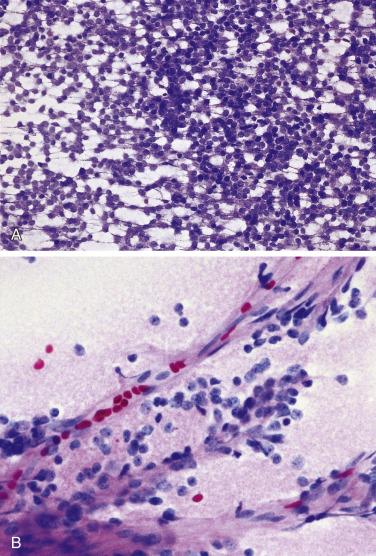
Optimal tissue fixation and processing are essential to obtain reliable results. The specimens should be received fresh from the operating room (see Fig. 17.5 ). Fragments of tissue should be fixed appropriately for potential ultrastructural studies. The remainder of the specimen should then be fixed promptly in formalin for routine paraffin embedding and sectioning. If tissue is abundant, a portion of the specimen may be frozen for further biochemical and molecular studies. In addition to the preparation of a hematoxylin and eosin (H&E)–stained slide, consecutive sections should be cut for reticulin silver impregnation ( Fig. 17.8 ) and immunohistochemical preparations for the pituitary hormones and transcription factors.

This author utilizes a stepwise protocol for analysis of the pituitary adenomas. An initial panel of antibodies for pituitary hormones is applied, including GH, PRL, ACTH, β-LH, β-FSH, β-TSH, and α-subunit (α-SU) of glycoproteins. If a tumor is still not classifiable by the pituitary hormone immunostains (i.e., immunonegative adenoma or faint/doubtful immunoreaction for hormones), immunostaining for the transcription factors Pit-1, SF1, and Tpit is added. Although immunoreactivity corresponds to hormone storage, it does not necessarily correlate with levels of hormonal synthesis or function.
Lactotroph adenomas, also called PRL-secreting adenomas and prolactinomas, constitute nearly 80% of functioning pituitary tumors and about 40% of all pituitary adenomas. However, most patients with lactotroph adenomas are treated clinically with dopamine agonist therapy. Therefore the frequency of prolactinomas in surgical series tends to be smaller; in our institution, lactotroph adenomas represent approximately 20% of tumor specimens. Most lactotroph adenomas are microadenomas occurring in reproductive-age women who present with oligomenorrhea, galactorrhea, and infertility. Conversely, in men and elderly women, lactotroph adenomas are usually macroadenomas and are most commonly associated with symptoms of a tumoral mass, including headaches, neurologic defects, and visual loss. Impotence and decreased libido are also common symptoms of hyperprolactinemia in males.
Lactotroph adenomas arise from Pit-1-lineage adenohypophyseal cells and express mainly prolactin (PRL). These tumors are classified into three distinct histologic subtypes: sparsely granulated lactotroph adenoma, densely granulated lactotroph adenoma, and acidophil stem cell adenoma.
The majority of lactotroph adenomas are sparsely granulated adenomas and composed of midsize cells with chromophobic cytoplasm and a central, oval nucleus ( Fig. 17.9 ). Small nucleoli can be present. The minority of the adenomas are densely granulated with cells containing copious eosinophilic cytoplasm. Microcalcifications that occasionally are so abundant as to form a so-called pituitary stone are commonly seen in lactotroph adenomas ( Fig. 17.10 ). The adenomas may also produce an amyloid-like substance, forming small hyaline bodies. Calcifications and amyloid bodies, although frequently seen in these tumors, are not pathognomonic of this type of adenoma but occur more frequently in lactotroph adenomas than in other adenoma types.

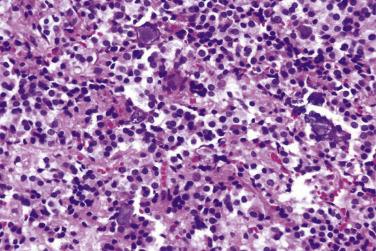
As commented previously, the majority of patients with PRL-secreting adenomas are treated to some degree with dopamine agonists before undergoing surgical resection. These drugs have direct effect on the tumor cells, inducing atrophy of lactotrophs with resultant tumor shrinkage. Histologically these treated lactotroph adenomas are composed of smaller tumor cells with shrinkage of the cytoplasm and hyperchromasia of the nuclei, in addition to variable degrees of perivascular and interstitial tumoral fibrosis ( Fig. 17.11 ).

In the majority of these adenomas (i.e., sparsely granulated adenomas) immunohistochemistry shows reactivity for PRL in a pattern of staining that is very characteristic, with localization near the nucleus in a dotlike pattern (see Fig. 17.9B ). This pattern is termed Golgi pattern by some authors, reflecting hormone localization in the Golgi complex. In densely granulated adenomas, strong and diffuse PRL expression is present. Lactotroph adenomas show nuclear expression of the acidophilic lineage-linked transcription factor Pit-1.
Sparsely granulated adenomas resemble actively secreting lactotrophs of the normal pituitary gland. The adenoma cells are characterized by prominent rough endoplasmic reticulum, conspicuous Golgi complex, and a sparse number of small (150–300 nm) secretory granules ( Fig. 17.12 ). Misplaced exocytosis, that is, granule extrusions on the lateral cell surfaces, is typical of these tumors.
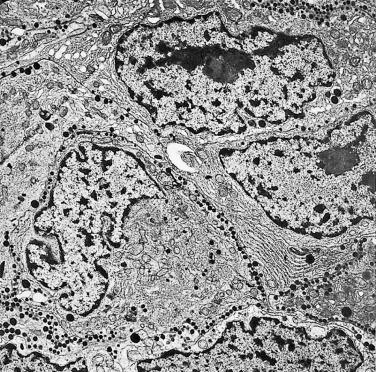
This unusual subtype of lactotroph adenoma is very rare and represents only the minority of PRL-secreting tumors. Most of the patients present with varying degrees of hyperprolactinemia; however, elevated GH levels may be present. The majority of these tumors are rapidly growing macroadenomas with invasive features. Because most of the patients have clinical features of hyperprolactinemia, the diagnosis is of clinical importance in that these tumors may be mistaken for the more benign prolactinomas.
By light microscopy, acidophilic stem cell adenomas are chromophobic with focal oncocytic change of the cytoplasm ( Fig. 17.13 ). Cytoplasmic vacuoles may be present and represent dilated and giant mitochondria as seen at the ultrastructure level (see upcoming discussion). Occasional fibrous bodies can be identified by low molecular weight CK immunostaining. Immunoreactivity for PRL and, to a lesser extent, GH is present in the cytoplasm of the same tumor cells. In addition, the adenoma cells are strongly positive for the Pit-1 transcription factor.
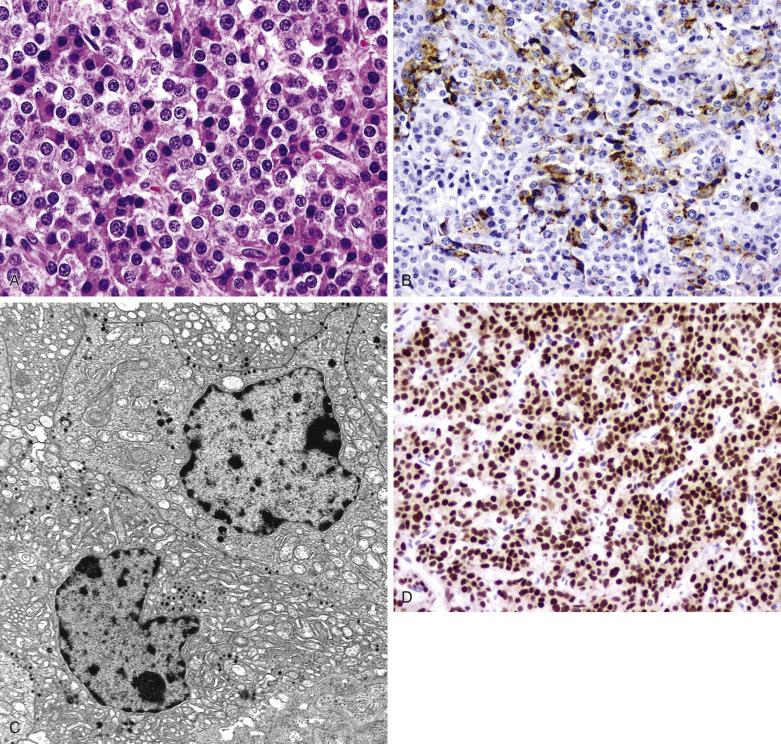
Electron microscopy may be necessary for precise identification of this adenoma. They are composed of a single population of immature cells exhibiting a sparse number of small secretory granules and occasional fibrous bodies (see Fig. 17.13C ). Oncocytic change with the presence of distinctive giant mitochondria occurs in the majority of cases.
Somatotroph adenomas constitute approximately 20% of pituitary adenomas. Patients have signs and symptoms of acromegaly or gigantism, and high serum levels of GH and insulin-like growth factor I (IGF-I). Acromegaly affects both sexes with similar incidence, and the mean age at diagnosis is 40 to 45 years. Symptoms of acromegaly usually progress slowly, with an average delay until diagnosis of approximately 10 years. Adenomas arising in children and adolescents before the epiphyseal closure of the long bones result in gigantism. Most patients with acromegaly have macroadenomas when first diagnosed, many of them with suprasellar expansion and parasellar invasion. Consequently, symptoms secondary to an expanding tumor mass, including headaches and visual field defects, may also be present in patients with large tumors. In about 30% to 50% of the patients, cosecretion of PRL with GH by the tumor results in signs and symptoms of hyperprolactinemia. The mixed GH and PRL-secreting tumors will be discussed in a following subsection.
Pure somatotroph adenomas are divided into two histologic subtypes: densely granulated somatotroph adenoma and sparsely granulated somatotroph adenoma. These histologic attributes reflect the amount of secretory granules present in the cell cytoplasm. The densely granulated somatotroph adenomas are characterized by eosinophilic tumor cells in which the cytoplasm shows considerable granularity, reflecting great numbers of secretory granules seen at the ultrastructural level ( Fig. 17.14 ). The nucleus tends to be central and oval, with prominent nucleoli. The sparsely granulated somatotroph adenomas are composed of smaller tumor cells with chromophobic cytoplasm and an eccentric nucleus ( Fig. 17.15 ). In the cytoplasm are paranuclear eosinophilic structures called fibrous bodies. These structures represent accumulations of intermediate filaments and tubular formations at the ultrastructural level and are strongly immunoreactive for cytokeratin ( Fig. 17.16 ).
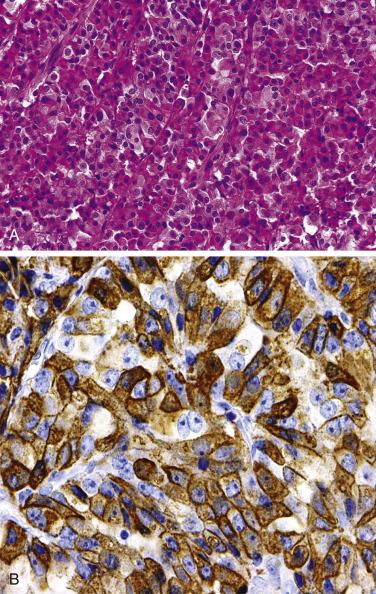
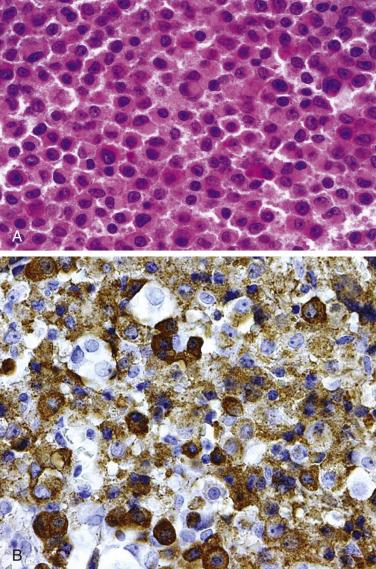
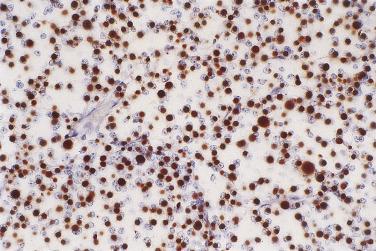
The distinction between the two subtypes of somatotroph adenomas is of importance because these tumors have different clinical behavior. The sparsely granulated adenomas exhibit more aggressive biologic behavior than the densely granulated adenomas. In addition, the response of tumors to adjuvant medical treatment also differs according to the subtype of somatotroph adenoma.
Immunohistochemical stains show a variable degree of GH immunoreactivity. In the densely granulated adenomas, the GH immunostain diffusely occupies the entire cytoplasm of the tumor cells and tends to be dispersed diffusely throughout the entire tumor (see Fig. 17.14 ). By contrast, in the sparsely granulated adenomas, GH immunostaining is focal within the tumor and tends to be localized in a paranuclear distribution (see Fig. 17.15 ) similar to the Golgi pattern seen in lactotroph adenomas. In addition, in these sparsely granulated adenomas, fibrous bodies are strongly positive for CK [45] (see Fig. 17.16 ). Some somatotroph adenomas show secondary reactivity for other pituitary hormones. Immunopositivity for PRL can be seen focally even in patients without clinical or biochemical evidence of hyperprolactinemia. Similarly, the presence of immunoreactivity for the glycoprotein hormones β-FSH, β-LH, α-SU, and less frequently β-TSH can be demonstrated in some somatotroph adenomas. Apart from the well-characterized mixed GH and PRL-secreting adenomas (see later discussion), plurihormonal differentiation is not clinically symptomatic in the majority of cases.
Immunohistochemical staining for low molecular weight CK is essential for further characterization of the two subtypes of somatotroph adenomas. The sparsely granulated adenomas are unique for the presence of dotlike cytokeratin staining of fibrous bodies, while the densely granulated adenomas show more diffuse cytoplasmic cytokeratin staining.
Somatotroph adenomas strongly express the acidophilic linkage transcription factor Pit-1.
The two subtypes of somatotroph adenomas, densely and sparsely granulated, are well characterized by ultrastructural analysis. However, as commented earlier, the distinction between these two clinically relevant somatotroph adenomas subtypes can be made based on immunohistochemistry for GH and CK patterns with no necessity for electron microscopy analysis on a routine basis. The densely granulated adenoma is composed of adenomatous cells that resemble the normal somatotrophs of the pituitary gland and are characterized by a well-developed rough endoplasmic reticulum network, prominent Golgi complexes, and numerous large (300–600 nm) secretory granules ( Fig. 17.17 ). The sparsely granulated adenomas have fewer and smaller (100–250 nm) secretory granules ( Fig. 17.18 ). The most characteristic feature of the sparsely granulated adenomas is the presence of fibrous bodies, which consist of an accumulation of intermediate filaments and tubular smooth-surfaced endoplasmic reticulum.
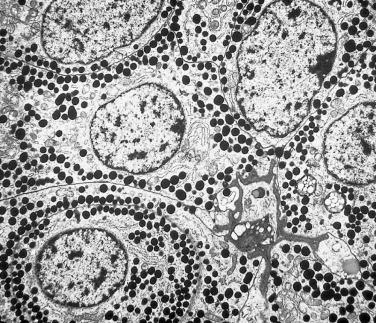
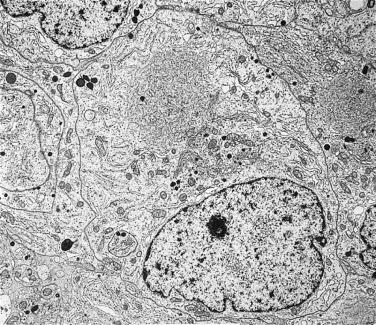
As in prolactinomas, medical therapy for acromegaly with somatostatin receptor ligands, mainly octreotide, is common practice in endocrinology. Unlike dopamine agonists, significant reduction of tumor cell size, resulting from involution of rough endoplasmic reticulum and Golgi membranes, is uncommonly seen in treated somatrotroph adenomas. The most common changes are varying degrees of perivascular and interstitial fibrosis.
As mentioned in the previous section, a large percentage of GH-secreting adenomas also secrete PRL. In this group of adenomas, two morphologic tumor types can be identified: the mixed somatotroph-lactotroph adenoma and the mammosomatotroph cell adenoma. The diagnosis of these adenomas may require a more complex immunohistochemical and ultrastructural analysis; however, their distinction has clinical and prognostic implications. In our experience, these mixed tumors behave more aggressively than any pure somatotroph adenomas, with a lower surgical cure rate.
The predominant clinical feature of mixed somatotroph-lactotroph adenomas is acromegaly. Signs and symptoms of hyperprolactinemia are not always apparent. Morphologically the tumors show a combination of eosinophilic densely granulated cells and chromophobic sparsely granulated cells, resembling densely granulated somatotrophs and sparsely granulated lactotrophs, respectively ( Fig. 17.19A ). Immunopositivity is demonstrated for both GH and PRL, with varying degrees of staining and distribution (see Fig. 17.19B and C ). The two cell types may form small groups or may be scattered. At the ultrastructural level, these adenomas are bimorphic tumors, consisting of two separate cell populations, densely or sparsely granulated GH cells and PRL cells (see Fig. 17.19D ).
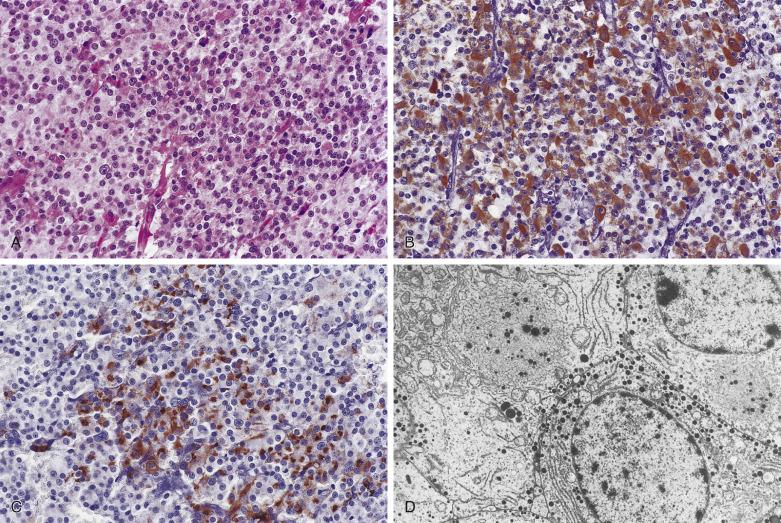
This rare mixed GH- and PRL-producing tumor accounts for fewer than 2% of all pituitary adenomas and about 8% of tumors associated with acromegaly. Similar to mixed somatotroph-lactotroph adenomas, these tumors are associated with elevated circulating GH and acromegaly; hyperprolactinemia is less common. Histologically the adenomas are acidophilic on H&E stain and immunohistochemistry demonstrates the presence of GH and PRL in the cytoplasm of the same tumor cells ( Fig. 17.20A–C ). These findings have been confirmed by double-labeling studies and immunoelectron microscopy. Ultrastructural analysis demonstrates a well-differentiated adenoma composed of a monomorphic cell population that shows features of GH and PRL cells (see Fig. 17.20D ). The tumor cells are most similar to densely granulated GH cells but with irregular secretory granules of variable sizes (200–2000 nm). Granule extrusions and extracellular deposits of secretory material are characteristically present, a feature consistent with PRL cell differentiation.
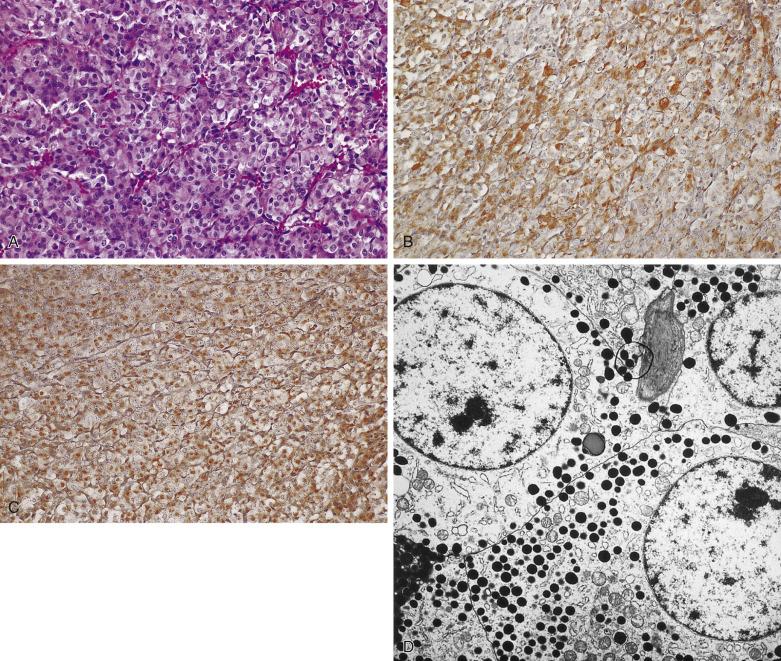
Corticotroph adenomas constitute two major groups: (1) endocrinologically active tumors associated with either Cushing disease or, very rarely, Nelson syndrome; and (2) tumors that are clinically nonfunctioning, the so-called silent corticotroph adenomas. Corticotroph adenomas associated with Cushing disease represent approximately 10% to 15% of all adenomas. Cushing disease tends to be more frequent in females (3.5 : 1 ratio) and affects patients of varying age, with a peak between 30 and 40 years. In children, Cushing disease is rare and tends to have a more aggressive clinical course and lower cure rate than in adults. In contrast to its occurrence in adults, Cushing disease arising in prepubertal children is more common in males than females. The great majority of corticotroph adenomas are microadenomas, and approximately 15% are invasive at the time of surgery.
Corticotroph adenomas are usually densely granulated, basophilic by H&E stain, and often strongly periodic acid–Schiff (PAS) positive. The cytoplasm is very granular, and the nucleus is large with coarse chromatin and a prominent nucleolus ( Fig. 17.21 ). Some degree of nuclear pleomorphism can be present. The cells have very distinct cytoplasmic borders and tend to touch each other in a tilelike arrangement. Papillary formations are very common. Adenomas with a more chromophobic appearance and less granular cytoplasm are also seen and designated as sparsely granulated corticotroph adenomas. Occasionally tumor cells exhibit hyaline bundles encircling the cytoplasm, giving a so-called target cell appearance, representing Crooke hyaline change. These hyaline bodies correspond to accumulation of CK intermediate filaments. Corticotroph adenomas showing extensive hyaline change, the so-called Crooke cell adenoma ( Fig. 17.22 ), appear more often to be locally invasive and recurrent.
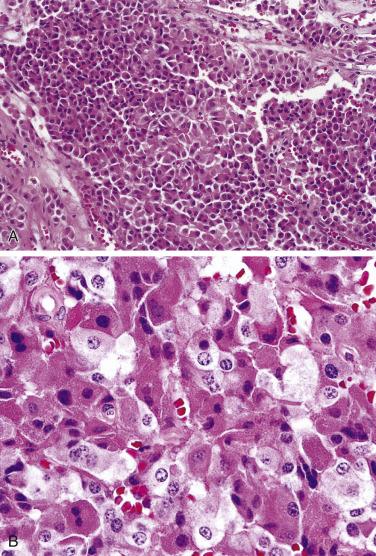
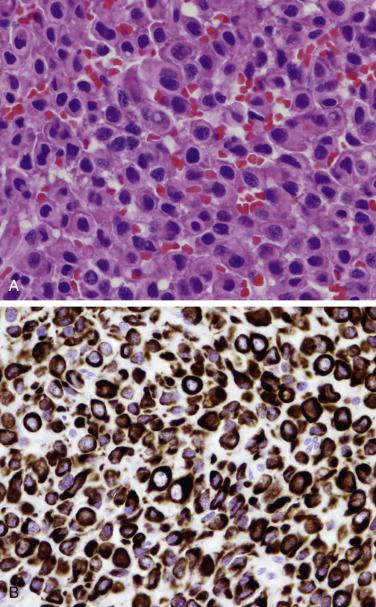
Crooke changes are also present in the normal pituitary gland of patients with Cushing disease and in patients with other pathologic or iatrogenic hypercortisolemic states; this cellular alteration appears to be a direct action of high serum levels of cortisol on the corticotroph cells.
Nelson syndrome, which is now quite rare, represents the syndrome of excess cortisol without any evident pituitary lesion on conventional radiography, leading to inappropriate adrenalectomy and later discovery of the pituitary adenoma. Corticotroph adenomas in this setting are histologically similar to adenomas associated with Cushing disease, with the exception that accumulation of intermediate filaments and Crooke hyaline change are not present.
On rare occasions, corticotroph cell hyperplasia may be the source of Cushing disease. However, controversy exists both from the clinical and pathologic viewpoints regarding this occurrence.
Immunohistochemical studies demonstrate the presence of ACTH with varying degrees of immunoreactivity ( Fig. 17.23 ) and the transcription factor Tpit. In addition, corticotroph adenomas may express other peptides related to the POMC precursor molecule, including β-lipotropin, β-endorphin, and α-melanocyte–stimulating hormone. In practice, the demonstration of these related peptides is less relevant than ACTH. Immunostaining for CK shows accumulation in the cytoplasm either diffusely or forming Crooke changes (see earlier discussion).
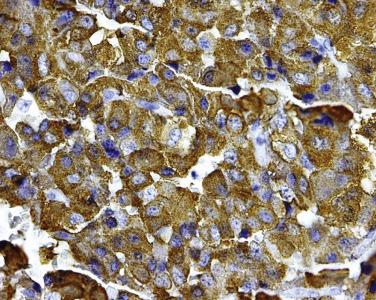
The ultrastructural features of corticotroph adenomas are characterized by well-differentiated cells that resemble normal corticotrophs. The cells contain well-developed organelles, including rough endoplasmic reticulum, smooth endoplasmic reticulum, and conspicuous Golgi, associated with numerous large (250–700 nm) secretory granules. The secretory granules are often of different shapes (teardrop, spherical, heart shaped) and vary in electron density. Bundles of intermediate filaments adjacent to the nucleus or forming large circles are easily identified. Ultrastructural analysis of clinically functioning corticotroph adenomas is not essential for diagnosis, as histologic and immunohistochemical studies are sufficient to provide an accurate diagnosis.
The silent corticotroph adenomas are characterized by immunoreactivity for ACTH despite the fact that the patients have neither clinical signs of Cushing disease nor serum levels reflecting excess ACTH secretion. Because silent adenomas are clinically nonfunctioning, the majority of them are macroadenomas and patients thus present with signs and symptoms of a mass lesion. Characteristically these adenomas show a high tendency for hemorrhage and apoplexy, which may be the presenting symptom in about a third of patients. Silent corticotroph adenomas tend to arise in patients older than those with Cushing disease.
Two types of silent corticotroph adenomas have been described according to tumors’ histologic appearance. The silent corticotroph adenoma subtype 1 (densely granulated adenoma) is morphologically indistinguishable from functioning corticotroph adenomas associated with Cushing disease, both on light microscopy and ultrastructure. The silent corticotroph adenoma subtype 2 shows different morphology from corticotroph adenomas and is characterized by amphophilic or mildly basophilic, sparsely granulated tumors that resemble null cell adenoma (see later discussion). The ultrastructure is less characteristic of a typical corticotroph cell adenoma or silent corticotroph subtype 1 adenoma. However, the morphology of the secretory granules has corticotroph characteristics. The tumor cells normally do not contain CK filaments. Rarely, some silent adenomas lack ACTH immunoexpression, but express the transcription factor Tpit.
Become a Clinical Tree membership for Full access and enjoy Unlimited articles
If you are a member. Log in here